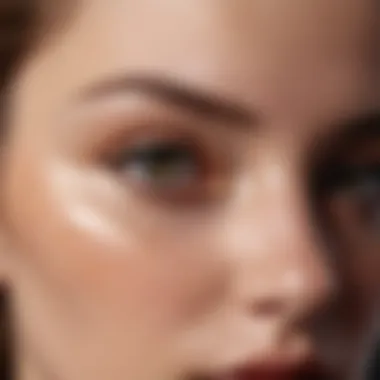Top Concealers for Hydrated Coverage on Dry Skin


Intro
Finding the right concealer can be a challenging task, particularly for those with dry skin. Dry skin often requires special attention, as using the wrong products can result in increased dryness, flakiness, and an uneven appearance. This guide dives into the nuances of selecting and using concealers tailored for dry skin types, ensuring that readers are well-informed about their options.
In this article, we will cover key elements of concealers, such as formulation, application techniques, and recommendations from experts. By understanding the unique needs of dry skin, our audience can make thoughtful decisions that lead to a flawless look without compromising skin hydration.
Key ingredients and consumer insights come into play throughout this exploration. From texture to longevity, these features are paramount to choosing an effective concealer. This guide is designed to improve both knowledge and application skills, ensuring readers can achieve their desired outcomes with ease.
Understanding Dry Skin
Dry skin is a widespread condition that significantly impacts the lives of many individuals. Understanding dry skin is essential for choosing the right cosmetic products, particularly when it comes to concealers. This article aims to provide in-depth knowledge on dry skin and its specific needs.
When skin lacks proper moisture, it can lead to discomfort and unsightly texture that makes makeup application challenging. Knowing the properties of dry skin can help consumers select products that enhance their natural beauty while improving skin health. Understanding dry skin also includes recognizing how certain ingredients can help or harm it. This foundation allows individuals to be informed and confident in their cosmetic choices.
Causes of Dry Skin
Dry skin can be caused by various factors, both environmental and internal. Some common causes include:
- Environmental factors: Seasonal changes, low humidity, and harsh weather conditions can strip moisture from the skin.
- Skin conditions: Eczema and psoriasis are underlying conditions that often result in dryness.
- Aging: As one ages, the skin naturally produces less oil, leading to a drier complexion.
- Lifestyle choices: Excessive washing, hot showers, and the use of harsh soaps may contribute to skin dryness.
- Health issues: Certain medical conditions, like diabetes and thyroid disorders, can affect skin moisture levels.
Symptoms Associated with Dry Skin
Identifying dry skin is straightforward, as it presents with distinct symptoms. Common symptoms include:
- A rough or flaky texture
- Red or irritated patches
- Tightness or discomfort, particularly after cleansing
- Cracks or fissures in severe cases
- Itching or a burning sensation
Recognizing these symptoms is crucial for individuals, as they signal the need for hydration and appropriate skincare products.
Impact of Dry Skin on Makeup Application
For those with dry skin, applying makeup can often be a complicated process. The condition can lead to several challenges:
- Difficulty in blending: Makeup may not sit well on the skin, leading to patchy or uneven coverage.
- Increased visibility of flaws: Dry patches can be accentuated by foundation and concealer, highlighting areas that need soothing and hydration.
- Product performance issues: Many formulations may cake or settle into fine lines, creating an unflattering appearance.
Understanding the impact of dry skin on makeup application is essential for selecting suitable products and techniques. With the right products, it is possible to achieve a smooth and flawless finish while maintaining skin hydration.
The Role of Concealer
Understanding the role of concealer is crucial for anyone with dry skin. Concealers not only cover imperfections but also ensure the skin appears even and smooth. They can enhance the complexion by hiding blemishes, dark circles, and redness. For people with dry skin, selecting the appropriate concealer becomes even more important. Using the wrong formulation may highlight dry patches, resulting in an undesirable effect.
What Does Concealer Do?
Concealer serves several purposes in makeup application. Its primary role is to mask flaws that foundation might miss. This includes discoloration and areas that require extra coverage. Unlike foundation, which provides an overall layer of coverage, concealer targets specific areas. This precision allows for a more polished look.
Additionally, concealers can brighten areas such as under the eyes, drawing attention away from fatigue. This characteristic is particularly beneficial for individuals who struggle with maintaining hydration in this delicate area.
Types of Concealer Formulations
Understanding the types of concealer formulations is essential for making informed choices. Different formulations can yield varied results, and knowing these differences can guide users in selecting the best option for their skin.
Liquid Concealers
Liquid concealers are often noteworthy for their versatile nature. They typically offer a buildable formula which allows for customizing the level of coverage. This feature makes them suitable for various skin types, especially dry skin. Key characteristics include a light texture that blends easily, preventing cakeiness.
Liquid formulas are generally easy to apply and can be used to achieve sheer to full coverage. However, their moisture levels can also vary significantly. Selecting a hydrating liquid concealer is crucial for avoiding the accentuation of dry patches.
Creme Concealers
Creme concealers are designed to provide full coverage. They offer thicker texture compared to liquid options. This characteristic makes them effective in concealing significant imperfections like scars or dark spots. Many individuals prefer them for their longevity and staying power.
However, because of their formulation, creme concealers can sometimes settle into fine lines or dry areas. Therefore, it is essential for those with dry skin to find a creme formulation that incorporates moisturizing ingredients.
Stick Concealers
Stick concealers present another popular alternative. They offer targeted application, allowing users to dab the product precisely where needed. This format is convenient and travel-friendly. Stick concealers usually provide good coverage; however, their texture can either be creamy or dry.
The key characteristic of stick concealers lies in their easy application and blendability. They work well for quick touch-ups throughout the day. But those with very dry skin should be cautious, as some stick formulations may emphasize dryness if they lack hydration.


Choosing the right concealer formulation is vital for individuals with dry skin. It ensures that they can achieve a flawless look without compromising hydrations.
Key Ingredients for Hydration
Understanding the key ingredients for hydration is essential in selecting the best concealer for dry skin. A concealer that effectively hydrates not only enhances the skin's appearance but also promotes its health. In this section, we will discuss several important components, including their unique benefits, characteristics, and how they contribute to achieving a flawless look while keeping the skin moisturized.
Moisturizing Agents
Glycerin
Glycerin is a humectant, meaning it draws moisture from the environment and helps retain it in the skin. This ingredient is a star for dry skin types as it can significantly improve hydration levels. The key characteristic of glycerin lies in its ability to absorb water, making it an ideal choice for makeup products aimed at combating dryness. One unique feature of glycerin is its non-greasy texture, which allows for comfortable wear throughout the day.
Advantages of Glycerin:
- Enhances moisture retention without making the skin feel oily.
- Promotes a plump and radiant appearance.
- Suitable for almost all skin types, including sensitive skin.
Disadvantages:
- In hot climates, glycerin may draw moisture from deeper skin layers, which could lead to dryness if hydration sources are insufficient.
Hyaluronic Acid
Hyaluronic Acid is renowned in the skincare community for its unparalleled ability to hold up to 1000 times its weight in water. This characteristic makes it crucial for products designed for dry skin, as it acts like a sponge, ensuring that skin remains hydrated for longer periods. Due to its lightweight nature, hyaluronic acid is particularly well-suited for concealers, adding hydration without bulk.
Advantages of Hyaluronic Acid:
- Provides intense hydration and plumpness to the skin.
- Improves skin elasticity, leading to a more youthful appearance.
- Non-irritating and safe for all skin types, including those with sensitive skin.
Disadvantages:
- In low-humidity environments, it may not perform as effectively, as there might not be sufficient moisture in the air for it to absorb.
Squalane
Squalane is a highly effective moisturizing agent derived from squalene, which is found naturally in our skin. It is known for its lightweight and silky texture, making it a favorite among those looking to maintain hydration without feeling heavy. This ingredient not only hydrates but also provides a protective barrier against environmental stressors. Its ability to mimic the skin's natural oils makes it an excellent addition to concealers meant for dry skin.
Advantages of Squalane:
- Instantly absorbs into the skin, leaving no greasy residue.
- Provides antioxidant protection, which can help combat free radical damage.
- Suitable for all skin types, including oily and acne-prone skins.
Disadvantages:
- Some formulations may use synthetic squalane, which might not provide the same benefits as natural sources.
Skin-Loving Additives
Vitamin E
Vitamin E is a powerful antioxidant that protects the skin from oxidative stress while promoting healing. Its moisturizing properties make it especially valuable in treating dry skin. The key characteristic of vitamin E stems from its ability to stabilize cell membranes, thereby preventing moisture loss and enhancing overall skin texture.
Advantages of Vitamin E:
- Provides nourishment and protection from environmental damage.
- Supports healing of dry and irritated skin.
- Enhances the overall texture of concealers.
Disadvantages:
- High concentrations may lead to breakouts in those with oily or acne-prone skin.
Aloe Vera
Aloe vera is often used in skincare for its soothing properties. It has a high water content, offering both hydration and a calming effect on irritated skin. The key characteristic of aloe vera is its ability to penetrate the skin, delivering moisture deep within. This makes it highly effective in concealers, especially for dry and sensitive skin types.
Advantages of Aloe Vera:
- Provides instant hydration and reduces inflammation.
- Improves skin texture and soothes irritation.
- Ideal for layering under makeup due to its lightweight feel.
Disadvantages:


- Some individuals may be allergic, leading to irritation.
Shea Butter
Shea butter is a rich emollient known for its deep moisturizing capabilities. It forms a protective barrier on the skin, locking in moisture effectively. The key characteristic of shea butter is its high-fat content, which provides nourishment and softness to the skin while also offering anti-inflammatory properties. This makes it a beneficial choice for those dealing with parched skin while using concealer.
Advantages of Shea Butter:
- Infuses the skin with essential fatty acids and vitamins.
- Creates a long-lasting barrier against moisture loss.
- Naturally soothing, making it an excellent option for sensitive skin.
Disadvantages:
- Its heavier texture may not be suitable for all skin types, particularly oily or combination skin.
Criteria for Selecting the Best Concealer
When you wander through the expansive world of concealers, making a choice can feel overwhelming, especially when your skin is dry. Therefore, understanding the selection criteria for the best concealer is crucial. A concealer should not only mask imperfections but also enhance your skin's natural glow without exacerbating dryness. These criteria will guide you to evaluate products effectively.
Understanding Your Skin Tone
Finding a concealer that complements your unique skin tone is fundamental. Skin tones can be broadly categorized into three groups: cool, warm, and neutral. To determine your undertone, observe the veins on your wrist; blue veins indicate cool tones, while greenish veins suggest warm tones. A neutral undertone often appears when both colors mix.
Choosing the right shade is essential for achieving a natural look. If the concealer is too light, it may stand out against your skin. Conversely, a shade too dark can create a shadow effect, making flaws more prominent. It’s beneficial to swatch options on your jawline rather than your hand, as this reflects how the color appears on your face. Consider brands like NARS and Estée Lauder, which offer a broader range of skin tone shades.
Finish and Coverage Level
The finish and coverage level of a concealer greatly influence your overall makeup look. Concealers are often available in matte, satin, or dewy finishes. A matte finish may not be ideal for dry skin, as it can accentuate flakiness and fine lines. Instead, a satin or dewy finish adds a hint of glow, helping to maintain a hydrated appearance.
Coverage levels are typically categorized from sheer to full. Sheer is ideal for minor imperfections, while full coverage effectively conceals blemishes and dark circles. However, too much coverage can lead to a cakey appearance, especially on dry skin. Ideally, look for products that offer buildable coverage. This feature allows you to layer the product without overwhelming your skin.
Testing Product Longevity
The longevity of a concealer is another aspect to consider. A product might look good at first, but how it performs throughout the day is significant. Test the concealer by applying it in the morning and monitoring how it holds up over several hours. Does it settle into fine lines? Does it fade away or change color? A formulation that is long-lasting without compromising hydration is essential for dry skin.
Carry out these tests in various conditions. Sometimes, indoor lighting can differ from natural light, affecting how the product appears. Consider using a setting spray or lightly dusting with a translucent powder to enhance longevity while keeping hydration in mind. This can provide a longer-lasting finish without creating a dry look.
By addressing these criteria—understanding skin tone, evaluating finish and coverage, and testing longevity—you can make a choice that enhances your natural beauty while respecting the needs of your dry skin. Remember, the objective is not just to cover imperfections but also to foster a healthy look.
Application Techniques for Concealer
In the quest for flawless skin, application techniques for concealer hold critical importance. The way you apply concealer can significantly affect its performance, especially for those with dry skin. Using the right methods ensures that the product adheres well, provides adequate coverage, and maintains the skin's hydration. Proper application techniques mitigate the appearance of dry patches and ensure that the concealer sits well on the skin without emphasizing fine lines.
Prepping Your Skin
Before applying concealer, it is vital to prepare the skin adequately. This preparation includes cleansing, exfoliating, and moisturizing. A clean canvas allows for better product adhesion. Exfoliation removes dead skin cells, which can lead to a smoother appearance. Moisturizing creates a hydrated base, essential for dry skin types. Consider using a nourishing primer specifically designed for hydration as an additional step.
Blending Techniques
Blending concealer properly can dramatically influence the finished look. There are various tools available, each contributing differently based on preference and technique.
Using Brushes
Using brushes is a popular method for applying concealer. Brush application allows for control over the amount of product used. The precision of a brush can help target specific areas, such as under the eyes or on blemishes. The key characteristic of a good concealer brush is its firmness, which helps in blending without soaking up too much product. One advantage of using brushes is the even distribution of the concealer. However, the downside can be the additional time needed for blending compared to other methods.
Using Makeup Sponges
Makeup sponges have gained popularity in recent years. They can provide a natural finish, absorbing excess product while blending seamlessly into the skin. The unique feature of makeup sponges is their ability to add moisture, making them excellent for dry skin types. Their soft texture allows for a gentle touch, suitable for sensitive areas like under the eyes. A common disadvantage is that sponges may absorb too much product, leading to a need for more than anticipated.
Fingers for Precision
Using fingers for concealer application is often underestimated. This method allows for warmth and natural pressure to blend and smooth out product. The key characteristic of this technique is its precision; fingers can easily reach small crevices or corners. Many users find it beneficial as it requires no additional tools. However, the potential drawback is uneven application if one is not careful.
Setting the Concealer
Once the concealer is applied and blended, setting it becomes necessary to ensure longevity and prevent creasing. Setting powders or sprays can help lock in the concealer. Opt for a lightweight translucent powder if using powder, as it won't add additional coverage. A spray can provide a more hydrated finish, which might be more suitable for dry skin.
"The right application techniques can elevate your makeup routine, making a visible difference in how concealer performs."


Top Recommendations
When selecting the best concealers for dry skin, having clear recommendations can significantly guide your choices. This section highlights key options across different categories to cater to various preferences and budgets. Each recommendation focuses on specific elements such as formulation, effectiveness, and customer satisfaction. By considering these aspects, consumers can navigate the overwhelming array of products with more confidence and discernment.
High-End Concealers
High-end concealers often provide superior formulations designed with advanced skin technologies. Brands like NARS and Too Faced offer products that specifically target dry skin concerns while delivering excellent coverage. The NARS Radiant Creamy Concealer, for instance, is celebrated for its creamy texture and ability to hydrate without settling into fine lines.
Advantages of high-end concealers include:
- Superior Ingredients: Many high-end brands incorporate premium ingredients such as hyaluronic acid and peptides.
- Enhanced Blendability: These products often blend seamlessly, providing a natural finish.
- Longevity: They typically offer longer wear without the need for frequent touch-ups.
Consumers looking for a luxurious option should consider investing in high-end concealers, as the benefits often justify the price.
Affordable Options
Finding effective concealers on a budget is possible. Brands such as Maybelline and L'Oreal produce quality options that rival their more expensive counterparts. The Maybelline Fit Me Concealer is known for its lightweight formula that covers imperfections while maintaining hydration.
Important aspects of affordable options include:
- Accessibility: Widely available in drugstores and online.
- Budget-Friendly: These products make it easier to maintain a quality makeup routine without overspending.
- Variety: Many drugstore brands offer a range of shades to suit diverse skin tones.
Affordable concealers can meet the needs of those who seek effective solutions without a hefty price tag.
Vegan and Cruelty-Free Selections
With growing awareness of ethical consumerism, many individuals look for vegan and cruelty-free makeup choices. Brands like e.l.f. Cosmetics and Tarte Cosmetics have prioritized creating products that align with these values. The Tarte Shape Tape Concealer not only covers well but is also renowned for its hydration properties and commitment to cruelty-free practices.
Points to consider for this category include:
- Ethical Practices: Vegan and cruelty-free brands often have clearer sourcing and testing policies.
- Quality Assurance: Many of these brands maintain high-quality standards to attract a socially conscious audience.
- Inclusive Formulas: They frequently provide a wide range of shades that cater to various skin tones and undertones.
By selecting vegan and cruelty-free concealers, consumers can feel good about their choices, aligning their values with their beauty routines.
"Choosing a concealer that meets your specific needs can significantly enhance your skincare and makeup experience."
Common Mistakes to Avoid
Applying concealer can be a straightforward process, but there are several common pitfalls that many encounter. Understanding these mistakes is crucial for achieving optimal results, especially for those with dry skin. Avoiding these errors can significantly enhance the effectiveness of your concealer, ensuring a flawless look without compromising skin health.
Applying Too Much Product
One major mistake is applying too much product. When you slather on an excess of concealer, it can settle into fine lines or dry patches. This not only highlights imperfections but can also create an uneven texture that detracts from your overall makeup. Typically, a small amount is sufficient. It's better to start with a little product and build up as necessary. This allows you to maintain a natural appearance while still covering any areas of concern.
The preferred approach is to use a tapping motion with your finger or a sponge. This technique ensures even coverage, helping the product to meld into the skin rather than sit on top of it. Additionally, a lighter application allows your skin to breathe, preventing further dryness.
Neglecting Hydration
Another common misstep is neglecting hydration before applying concealer. Hydration plays a pivotal role in how well makeup adheres to the skin. If your skin is not properly moisturized, any concealer will likely exacerbate dryness and flakiness. Using a good moisturizer or hydrating primer is fundamental.
When choosing products, look for those with hydrating ingredients like hyaluronic acid or glycerin. Often, people skip this step, thinking that concealer will cover up any dryness. However, without proper hydration, the concealer can fail to perform effectively, leading to an uneven and patchy finish.
Hydrated skin results in improved makeup application and longevity, making hydration an essential step.
Using Incompatible Formulations
Using incompatible formulations is yet another mistake many make. Not all concealers work well with all skin types. Liquid concealers can be great for dry skin, but if you have a dry texture, applying a matte formula can worsen the situation. Matte formulations often absorb moisture from the skin, leading to further dehydration. On the other hand, cream-based or hydrating concealers provide a better match for those with dry skin.
Moreover, it’s important to consider your foundation and other makeup products. A mismatch in textures between foundation and concealer can lead to a lack of cohesion in your makeup application. Always test formulations together to see how they interact. Combining a hydrating foundation with a matte concealer could lead to uneven results.
In summary, by avoiding these common mistakes—applying too much product, neglecting hydration, and using incompatible formulations—you can ensure a smoother and more graceful application of concealer. Understanding these factors will enhance not only the appearance of your makeup but also the overall health of your skin.
Epilogue
Selecting the right concealer for dry skin is an important endeavor that can significantly impact your overall makeup experience. The proper product not only masks imperfections but also enhances your skin’s natural appearance while preserving hydration. In this article, we have examined various aspects of concealer tailored to dry skin, ensuring that every reader leaves with a well-rounded understanding of their options.
Final Thoughts on Selecting the Right Concealer
When it comes to choosing a concealer, several critical factors should be considered. First, understanding your skin tone is essential. It will help you select a color that not only blends seamlessly but also complements your natural coloring. Look for shades that are similar to your foundation or slightly lighter for a brightening effect.
Another important consideration is the finish and coverage level of the concealer. For dry skin, products that offer a hydrating formula with a dewy or satin finish tend to be more flattering. These finishes can prevent the product from emphasizing dry patches or uneven texture.
Lastly, testing product longevity before settling on a choice is wise. Concealers that fade or cake throughout the day can negate the benefits of good hydration and coverage. A successful concealer should remain intact and retain its effectiveness from morning to night.
"Finding the right concealer is not merely about color matching; it involves understanding your skin's needs and how different formulations work together with your natural texture."



